|
Books Should Be Free Loyal Books Free Public Domain Audiobooks & eBook Downloads |
|
|
Books Should Be Free Loyal Books Free Public Domain Audiobooks & eBook Downloads |
|
Non-fiction |
|---|
|
Book type:
Sort by:
View by:
|
By: Mary Roberts Rinehart (1876-1958) | |
|---|---|
 Through Glacier Park
Through Glacier Park
This is about a three-hundred mile trip across the Rocky Mountains on horseback with Howard Eaton. It is about fishing, and cool nights around a camp-fire, and long days on the trail. It is about a party of all sorts, from everywhere, of men and women, old and young, experienced folk and novices, who had yielded to a desire to belong to the sportsmen of the road. And it is by way of being advice also. Your true convert must always preach. (Introduction by Mary Roberts Rinehart quoted from the text.) | |
By: Mary Rowlandson (c.1637-1711) | |
|---|---|
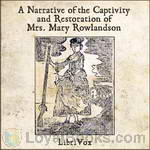 A Narrative of the Captivity and Restoration of Mrs. Mary Rowlandson
A Narrative of the Captivity and Restoration of Mrs. Mary Rowlandson
This is the story of Mary Rowlandson’s capture by American Indians in 1675. It is a blunt, frightening, and detailed work with several moments of off-color humor. Mary, the wife of a minister, was captured by Natives during King Philips War while living in a Lancaster town, most of which was decimated, and the people murdered. See through her eyes, which depict Indians as the instruments of Satan. Her accounts were a best-seller of the era, and a seminal work, being one of the first captivity narratives ever published by a woman... | |
By: Mary Stoyell Stimpson | |
|---|---|
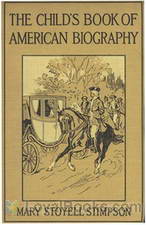 The Child's Book of American Biography
The Child's Book of American Biography
In every country there have been certain men and women whose busy lives have made the world better or wiser. The names of such are heard so often that every child should know a few facts about them. It is hoped the very short stories told here may make boys and girls eager to learn more about these famous people. (from the Forward of the text) | |
By: Mary Wollstonecraft (1759-1797) | |
|---|---|
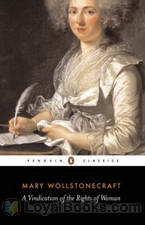 A Vindication of the Rights of Woman
A Vindication of the Rights of Woman
Regarded as the one of the earliest examples of feminist philosophy, A Vindication of the Rights of Woman is written as a direct response to Charles Maurice de Talleyrand-Périgord, a French politician who delivered a report to the French National Assembly suggesting that women should only receive domestic education and additionally encourages women to stay clear of political affairs. In her treatise, Wollstonecraft avidly criticizes this inadequate perception of women as an inferior sex and attacks social inequality, while also arguing for women’s rights in the hope of redefining their position both in society and in marriage... | |
 Letters Written During a Short Residence in Sweden, Norway and Denmark
Letters Written During a Short Residence in Sweden, Norway and Denmark
Published in 1796, Letters Written During a Short Residence in Sweden, Norway, and Denmark is a personal travel narrative by the eighteenth-century British feminist writer Mary Wollstonecraft. The twenty-five letters cover a wide range of topics, from sociological reflections on Scandinavia and its peoples to philosophical questions regarding identity. Published by Wollstonecraft's career-long publisher, Joseph Johnson, it was the last work issued during her lifetime. Wollstonecraft undertook her tour of Sweden, Norway, and Denmark in order to retrieve a stolen treasure ship for her lover, Gilbert Imlay... | |
 Original Stories from Real Life
Original Stories from Real Life
Mary Wollstonecraft was one of the early promoters of gender equality long before other crusaders took up the cause. She is perhaps best known for her books, “A Vindication of the Rights of Women” and “A Vindication of the Rights of Men” . But she also wrote widely on education and used fiction formats to promote her progressive views. This book using the genre of didactic children’s stories, was written the same year as her “Mary: A Fiction” 1788, but was first published anonymously... | |
By: Mary Wollstonecraft Shelley (1797-1851) | |
|---|---|
 Lodore
Lodore
The author of Frankenstein returns with her take on an Austen novel. The mother is proud, the father has many vices, yet the aristocratic name must be kept. Even more so when lord Lodore dies. His wife and daughter find themselves without protection. This novel is conserned with gender equality, education and social justice. - Summary by Stav Nisser. | |
By: Maurice Maeterlinck (1862-1949) | |
|---|---|
 The children's Life of the Bee
The children's Life of the Bee
Buzz, buzz, buzz. A fascinating and beautifully written explanation of the life of the honey bee. Is the queen the master of the hive or just a hard working servant? What is the purpose of the drones? Why do bees make honey? Do bees ever sleep? Why do bees swarm? Maeterlinck, who won the Noble Prize for Literature, wrote a more scholarly work called The Life of the Bee but then rewrote it in simpler terms so that children could appreciate what goes in a hive. The book describes in simple language the inner workings of a hive from its beginning with a swarm to the fully functional hive with thousands of workers, drones and a queen busily building, repairing and gathering. | |
By: Max Stirner (1806-1856) | |
|---|---|
 The Ego and His Own
The Ego and His Own
In this book, his most famous, Max Stirner presents a philosophical case for a radical egoism that shuns the socially-oriented outlooks of both "establishment" ideologies and of revolutionaries in favor of an extreme individualism. The book is most widely talked about today only through the lens of other philosophers' thought: Karl Marx and Friedrich Engels launched a famous assault on it in The German Ideology, and some draw a connection between Stirner's thoughts here and Nietzsche's egoism a generation later. But it is worth reading in its own right, as much for its lyricism as the challenge of its philosophical proposals. | |
By: May Gillington Byron (-1936) | |
|---|---|
 Days with the Great Composers
Days with the Great Composers
These light entertainments, originally published anonymously, are an imagined day in the life of each composer (Beethoven, Mendelssohn, Schubert, Chopin, Wagner, Gounod, Mozart, Schumann, Tschaikovsky). This gives the author scope to describe each one's work and life, sketchily, of course, but interestingly. | |
By: May Kellogg Sullivan | |
|---|---|
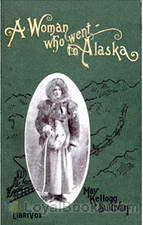 A Woman Who Went to Alaska
A Woman Who Went to Alaska
Alaska has only been a state since 1959, and the breathtaking terrain remains mostly unspoiled and natural. In modern times, many of us have had the pleasure of visiting Alaska via a luxurious cruise ship, where we enjoyed gourmet meals, amazing entertainment, and a climate-controlled environment. It's easy to also book a land package that enables you to see more of the country by train.Imagine what it was like to visit the same wild, untamed countryside in 1899. Instead of boarding a sleek, stylish cruise ship, you travel for weeks on a steamer... | |
By: May Sinclair (1863-1946) | |
|---|---|
 Defence of Idealism
Defence of Idealism
The philosophy of Idealism, revived in eighteenth-century Europe by George Berkeley, argued against philosophical materialism by maintaining that Reality is a creation of the Mind. Despite its flourishing under the leadership of Hegel, Fichte, Schopenhauer, and Schelling, Idealism had definitely fallen into decline late in the nineteenth century and early in the twentieth. May Sinclair, the writer of many popular but philosophically provocative novels and part-time World War I ambulance corps-person, was an unlikely one to take up the torch of the old school and try to revive it yet again for the twentieth century... | |
By: Melvin Powers (author still living) | |
|---|---|
 A Practical Guide to Self-Hypnosis
A Practical Guide to Self-Hypnosis
Published in 1961, A Practical Guide to Self-Hypnosis by Melvin Powers is a self help book that aims to bring the basic techniques of hypnosis to the ordinary reader and harness its legendary powers to one's own advantage. In fact, all forms of hypnosis are essentially self-hypnosis since the process does not work without the overt or covert cooperation of the person who is being hypnotized. The main difference is that all other forms of hypnosis require the guidance of a therapist or hypnotist while the one suggested here is a self-guided procedure... | |
By: Meredith Nicholson (1866-1947) | |
|---|---|
 Broken Barriers
Broken Barriers
Life abruptly changes for young socialite, Grace Durland., when her father goes bankrupt and she is forced to earn a living. Thrust into a new life, she meets -- and falls in love with -- a married man. She faces condemnation from friends and family alike, and although Ward Trenton reciprocates her feelings, his wife refuses him a divorce. Once again, fate intervenes in the form of a serious accident. - Summary by Lynne Thompson | |
By: Meriwether Lewis (1774-1809) | |
|---|---|
 The Journal of Lewis and Clarke (1840)
The Journal of Lewis and Clarke (1840)
"The expedition of Messrs. Lewis and Clarke, for exploring the river Missouri, and the best communication from that to the Pacific Ocean, has had all the success which could be expected. They have traced the Missouri nearly to its source; descended the Columbia to the Pacific Ocean, ascertained with accuracy the Geography, of that interesting communication across the continent; learned the character of the country, its commerce and inhabitants; and it is but justice to say that Messrs. Lewis and Clarke, and their brave companions, have, by this arduous service, deserved well of their country... | |
By: Michael Combrune | |
|---|---|
 Theory and Practice of Brewing
Theory and Practice of Brewing
This is an elaborate treatise on how to brew beer. That art is as noble today as it was in 1761, when this book was first published, and Mr. Combrune was a master of his art. After reading his work on this topic, a glass of beer can be enjoyed on quite a different level. - Summary by Carolin | |
By: Michael Faraday (1791-1867) | |
|---|---|
 The Chemical History of a Candle
The Chemical History of a Candle
The Chemical History of a Candle is a series of 6 lectures on chemistry presented to a juvenile audience in 1848. Taught by Michael Faraday - a chemist and physist, and regarded as the best experimentalist in the history of science - it is probably the most famous of the Christmas Lectures of the Royal Society. Taking the everyday burning of a candle as a starting point, Faraday spans the arc from combustion and its products, via the components of water and air (oxygen, hydrogen, nitrogen, carbon), back to the type of combustion that happens in the human body when we breathe... | |
By: Michel Eyquem de Montaigne (1533-1592) | |
|---|---|
 Essays, Book 1
Essays, Book 1
Michel Eyquem de Montaigne is one of the most influential writers of the French Renaissance, known for popularising the essay as a literary genre and is popularly thought of as the father of Modern Skepticism. He became famous for his effortless ability to merge serious intellectual speculation with casual anecdotes and autobiography—and his massive volume Essais (translated literally as "Attempts") contains, to this day, some of the most widely influential essays ever written. | |
By: Mikhail Bakunin (1814-1876) | |
|---|---|
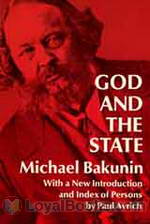 God and the State
God and the State
Bakunin’s most famous work, published in various lengths, this version is the most complete form of the work published hitherto. Originally titled “Dieu et l’état”, Bakunin intended it to be part of the second portion to a larger work named “The Knouto-Germanic Empire and the Social Revolution” (Knouto-Germanic Empire is in reference to a treaty betwixt Russia and Germany at the time), but the work was never completed. (from book introduction) | |
By: Mildred Duff (1860-1932) | |
|---|---|
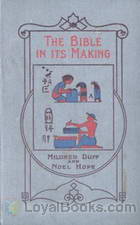 The Bible in Its Making - The Most Wonderful Book in the World
The Bible in Its Making - The Most Wonderful Book in the World
One great universal law runs through the realm of nature. Our Saviour gave it in a sentence: 'First the blade, then the ear, after that the full corn in the ear.' It is with the desire to show that the same law rules in another of God's creations — The Bible — that this little volume has been prepared. The Bible has as literally 'grown' as has an oak tree; and probably there is no more likeness between the Bible as we know it to-day and its earliest beginning, than we find between the mighty tree, and the acorn from which it sprang... | |
By: Mírzá Abu’l-Fadl Gulpáygání (1844-1914) | |
|---|---|
 The Brilliant Proof (Burhäne Lämé) in reply to an attack upon the Bahai Revelation by Peter Z. Easton
The Brilliant Proof (Burhäne Lämé) in reply to an attack upon the Bahai Revelation by Peter Z. Easton
“In these days,” writes the renowned Bahá’í scholar, Mírzá Abu’l-Fadl, “which are the latter days of 1911, A. D. and the early days of 1330 A. H., I have seen a curious article which astonished me. What did I see? I find that one of the missionaries of the Protestant sect, who accounts himself among the learned men of the twentieth century, a helper of the pure religion of Christ and one of the civilized and cultured occidentals, by name, Peter Z. Easton, has been so provoked by jealousy... | |
By: Mohandas Karamchand Gandhi | |
|---|---|
 Third Class in Indian Railways
Third Class in Indian Railways
Mohandas Karamchand Gandhi (1869 – 1948) was the pre-eminent political and spiritual leader of India during the Indian independence movement. He was the pioneer of satyagraha — resistance to tyranny through mass civil disobedience. This philosophy was firmly founded upon ahimsa, or total nonviolence, and led India to independence and inspired movements for civil rights and freedom across the world. Gandhi is commonly known around the world as Mahatma Gandhi and in India also as Bapu. He is officially honoured in India as the Father of the Nation; his birthday, 2 October, is commemorated there as Gandhi Jayanti, a national holiday. | |
 Guide to Health
Guide to Health
Mahatma Gandhi, known today as a fascinating political leader and pacifist, also considered himself "something of an authority on matters of Health and Disease as well. Very few of us perhaps are aware that he is the author of quite an original little Health-book in Gujarati. [...] His views are of course radically different from the ordinary views that find expression in the pages of such books; in many cases, indeed, his doctrines must be pronounced revolutionary, and will doubtless be regarded by a certain class of readers as wholly impracticable... | |
By: Moncure D. Conway (1832-1907) | |
|---|---|
 Autobiography Memories and Experiences, Volume 1
Autobiography Memories and Experiences, Volume 1
Moncure Daniel Conway was an American abolitionist, Unitarian, clergyman and author. This first volume of his autobiography covers roughly the years of his birth through the end of the US Civil War. | |
By: Moncure Daniel Conway (1832-1907) | |
|---|---|
 Autobiography Memories and Experiences, Volume 2
Autobiography Memories and Experiences, Volume 2
Moncure Daniel Conway was an American abolitionist, Unitarian, clergyman and author. This second volume of his autobiography covers the years from the US Civil War to roughly 1904. | |
By: Mrs. Cecil Hall | |
|---|---|
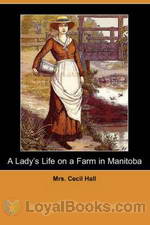 A Lady's Life on a Farm in Manitoba
A Lady's Life on a Farm in Manitoba
The nineteenth century was marked by intense colonization by countries like Britain, France, Portugal, Spain and the Netherlands. Initially, the pioneering efforts were made by men who battled unfamiliar terrain to create territories that they marked out as their own, while their wives, mothers, sisters and daughters kept the home and hearth in their native land. However, with travel becoming more common and family life assuming more importance, the women too began to travel to the four corners of the earth... | |
By: Mrs. Eugenia Dunlap Potts (1840-1912) | |
|---|---|
 Historic Papers on the Causes of the Civil War
Historic Papers on the Causes of the Civil War
While claiming to be historical papers on the causes of the United States Civil War, the author indulges in some Slavery Apologetics. An interesting view from a southern lady on what caused the war and why the south was the underdog. | |
By: Mrs. Humphry | |
|---|---|
 Manners for Men
Manners for Men
Many men who go out into the world while still very young to earn their living have few opportunities of acquiring a knowledge of social observances. Should this little manual of manners be of use to any such in enabling them to master the theory, as it were, of social customs in the educated classes, it will have attained its aim. | |
By: Mrs. Isabella Beeton (1836-1865) | |
|---|---|
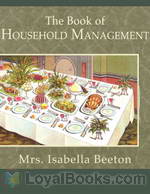 The Book of Household Management
The Book of Household Management
“Mrs. Beeton’s” is a guide to all aspects of running a household in Victorian Britain. Published in 1861, it was an immediate bestseller, running to millions of copies within just a few years. In the cookery sections, Mrs. Beeton follows the animal “from his birth to his appearance on the table.” Learn how to care for poultry during moulting season, how to wean calves, how to cure hams, salt cod, carve mutton, and much more. | |
By: Myrtle Reed (1874-1911) | |
|---|---|
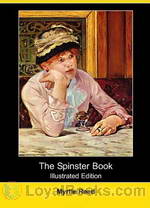 The Spinster Book
The Spinster Book
A cross between guidebook and social commentary, The Spinster Book gives clever and humorous insights on topics such as courting, handling men and women, love letters, marriage and spinsterhood. | |
By: N. E. Dionne (1848-1917) | |
|---|---|
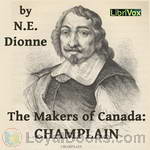 The Makers of Canada: Champlain
The Makers of Canada: Champlain
A biography of Samuel de Champlain, French explorer, founder of Quebec, and father of New France. ( | |
By: Nagarjuna | |
|---|---|
 She-rab Dong-bu (The Tree of Wisdom)
She-rab Dong-bu (The Tree of Wisdom)
The She-rab Dong-bu (Tree of Wisdom) is a metrical translation in Tibetan of a Sanscrit ethical work entitled Prajnya Danda, written by Nagarjuna who flourished in the fourth century of the Buddhist era (about 100 B.C.), The Tibetan version was probably made about the 11th century of our era but the exact date has not been determined. It is included in the Ten-gyur, ངོ་ section, volume གོ་, beginning at leaf 165. The Tibetan translator describes it as the second volume but I cannot say whether the remainder of the work has been preserved in Tibetan – the Sanscrit original is apparently lost. | |